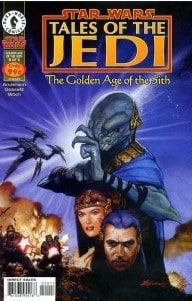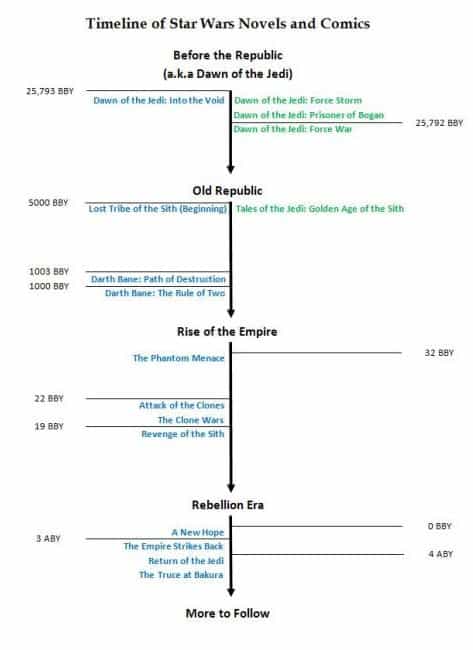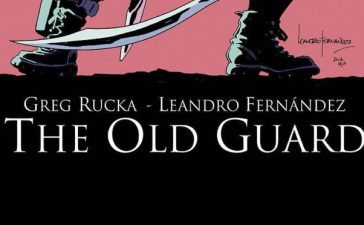
Discovering the History of the Star Wars EU: Tales of the Jedi: The Golden Age of the Sith

Of the stories I know thus far, this next chapter brings me into what may be my favorite era in the Star Wars timeline. Last week I talked about the Dawn of the Jedi, an era set less in absolutes and more between the shades of gray. Had Dark Horse not lost the rights to Star Wars and Disney not discontinued the “Legends” line (the name given to every story other than the six films, The Clone Wars movie and animated series, Disney’s Rebels, and all the books published before the release of John Jackson Miller’s A New Dawn) I’m sure there would have been more novels and comics set during the period. With more material, I could easily see that becoming another favorite of mine. Alas, that age has drawn to a close, and we are entering the Old Republic Era, beginning 5000 years Before the Battle of Yavin (BBY).
The comics’ timeline gives Tales of the Jedi as beginning in 5000 BBY, and the book timeline gives John Jackson Miller’s Lost Tribe of the Sith: The Collected Stories as taking place that same year (well, the first part of the novel–it makes several time jumps).
As I stated last week, if a novel and a comic take place in the same year, I will read the novel first, so I started with Lost Tribe and found that it opens a little after the first volume of Tales of the Jedi. By the time the book begins, Naga Sadow had already come to power, and the comics shows his rise to Dark Lord of the Sith.
Before getting into the specifics of the story, I’d like to clarify Sith terminology. Originally, there were Light V Dark Jedi. Jedi V Sith would not come about until 6900 BBY when the Dark Jedi conquered the red, tendril-faced species known as Sith. It was from these beings that the Dark Jedi found a name for their philosophy of evil. John Jackson Miller makes the distinction simple in Lost Tribe by calling the species Red Sith and the Dark Force wielders Sith. I will use the same classification when needed.
The Golden Age of the Sith, the first volume (chronologically) of Tales of the Jedi, was written by Kevin J. Anderson (Jedi Academy trilogy) and penciled by Dario Carrasco Jr. It ran for five issues, with a zero issue to introduce the story (drawn by Chris Gossett). Here we are introduced to Gav and Jori Daragon, whose parents are preparing to fly a supply run to the forces on Kirrek, the last planet to join Empress Teta’s unification of the seven worlds in the Koros system. Pirates against the unification have gathered to prevent Teta’s forces from reaching the planet. On their home-planet Koros Major, Gav and Jori are both eager to join in on aiding the Pro-Teta Kirrek cadre, but there parents refuse, deeming the run too dangerous for their children.
Next we have Jedi Odan-Urr, a Draethos who’d rather spend time studying the galaxy’s history in the library than find himself in combat. Odan-Urr’s master, Ooroo, of a wild-looking brain species called Celegian, orders his Padawan to aid Empress Teta in the Unification War. The master explains there is much more to being a Jedi than what you can learn in a book. Reluctantly, Odan-Urr obeys.
Meanwhile, the fight on Kirrek has turned sour. Teta’s forces do their best to advance on the pirate enemies, but they are beginning to lose hope. Odan-Urr remembers a war strategy the learned of during his studies called the Jedi Battle Meditation. Through the use of the Force, Odan-Urr and Teta’s Jedi Advisor Memit Nadill bridge the Galactic Republic warriors’ minds together and fill them with hope, inspiring them to fight harder. The meditation also affects the opposing pirates by weakening their spirits, making victory seemingly impossible.
The Jedi Battle Meditation works, but there are still heavy losses. Two of whom are Gav and Jori’s parents. With their parents gone, Aarrba the Hutt, possibly the only benevolent slug in the galaxy, agrees to give them the family’s ship that he was holding on to until the Daragon’s paid their repair costs and look after them.
As is clearly noticeable, the zero issue had nothing whatsoever to do with the Sith. In fact, there are no Sith involved until issue #2. But I find this to be a good thing. While I’m excited to see the Sith, the reader needs to feel connected to the rest of the characters in order to make anything that happens to them mean something. Without the attachment, the reader wouldn’t care if the Sith won or lost.
Issue #1 introduces a facet of the Star Wars lore that I had never thought of, but is incredibly cool. While hyperspace travel is wildly available, it is still in its infant stages. Plotting a course through hyperspace requires just that, a course! But how were the routes determined? Well, this issue answers the question. Gav and Jori, flying their parents’ Starbreaker 12, attempt to make a life for themselves by plotting courses through hyperspace, finding if they are safe or not, and then selling the information to galactic space control. Unfortunately, the latest run, though mildly successful, damaged their ship. Aarrba the Hutt agrees to fix their ship, but will not give it back to them until they pay him his money.
All is well until Ssk Kahorr, merchant lord, sends one of his drone ships down the course the siblings plotted and it is destroyed. Seeking revenge for all the money he lost, Ssk Kahorr sends two bounty hunters after Gav and Jori. Luckily, they are saved by Odan-Urr and Memitt Nadill, who then explain it would be best for them to leave the planet for a while. Not knowing where to turn, the children steal the Starbreaker 12 from Aarrba and plot a course a random, hoping to find a better life elsewhere. And as Star Wars luck has it, they wind up in Sith space.
Issue #2 brings the reader to Korriban where there is a funeral for the recently deceased Dark Lord Marka Ragnos. Korriban, once the central hub for the Sith Empire, is a barren world, lined with temples. It swarms with Dark Side energy. Home to the Red Sith, it was on Korriban that the Dark Jedi first met the Reds. From there, the inbreding essentially erased the distinction between the two, Red Sith and Dark Jedi becoming Sith. Leading the funeral procession is Ludo Kressh, top contender for the next Dark Lord. However, his climb to the top is challenged by Naga Sadow, both are Red Sith.
They called this The Golden Age of the Sith. I wonder if this is in part due to the fact that they’ve remained hidden for the Jedi and the Republic, and thus run unopposed by any faction other than its own. There is a reason Darth Bane set into play the Rule of Two (around 1000 BBY). This new rule would temporarily end the Sith as a society, and instead only allow for two Sith, master and apprentice, at any given time. Once the apprentice was strong enough to slay his/her master, the cycle would begin anew.
But this is still 4000 years before Darth Bane’s reign. During the Golden Age, there were no Darths; there were Lords and a Dark Lord (the head honcho). The Sith community strove to place self over all else, meaning a society of these guys was essentially impossible to sustain. There is always a plot to usurp leadership and scheming as to how to best screw over the guy gunning for you. The problem is not in obtaining power but in holding on to it once you’re there.
Before a fight can break out between Naga Sadow and Ludo Kressh, the spirit of Marka Ragnos appears before them, warning them that it is not each other they should be fighting. Despite the warning, both are still eager to destroy the other and claim the title of Dark Lord. This is when Gav and Jori are found and taken prisoner and held on Ziost.
Ziost was used as a capital for the Dark Jedi during the Hundred Year Darkness (roughly 7000-6900 BBY). It was during this time that the Dark Jedi turned on the rest of the order. Although they were defeated, the Dark Jedi were able to take Korriban from the Red Sith first.
Immediately, Naga Sadow realizes the potential of using the siblings to further his bid for leader. Staging an attack against the Sith, Sadow sends his Massassi warrior (another conquered species by the Sith) to steal a weapon from aboard the Starbreaker 12. Using the gun to slay Sith forces, Sadow pins the attack on the Republic. He sends Gav and Jori to two different fortresses, telling them he is helping them until they can return home.
Distraught by the “Republic attack,” all the Sith name Naga Sadow the new Dark Lord of the Sith…everyone but Ludo Kressh and his followers that is. Naga Sadow demands they take the fight to the Republic and conquer their space, but Kressh is of the mind that they would be better off remaining hidden and continuing to operate in the shadows. Did the Sith place their trust with the wrong leader?
Meanwhile, Odan-Urr has a vision of the Sith coming to fight to Republic. He warns Empress Teta, who brings him to Coruscant to warn the Galactic Republic leaders of the coming storm. However, it has been years since anyone has heard from the Dark Jedi, and most now believe them to be no more than myth. Odan-Urr is laughed away from the forum. The only ones who believe him are the Jedi present for the meeting.
The reluctance to believe in a deadly force approaching home is a motif often used in the Star Wars universe. No matter who is in change, the ruling party seems to always grow overconfident. This overconfidence is often the catalyst for change in the galaxy.
All the while, Naga Sadow has kept brother and sister separated from each other. He is using his time with Gav to train him in the ways of the Dark Side. Gav is easily manipulated. Without warning, Ludo Kressh attacks Sadow. Sadow tells Jori she has to escape immediately, and he “finds a way” for her to get back on Starbreaker 12. This is, of course, his ultimate plan. Although Jori is reluctant to leave her brother, she uses the coordinates programmed in the ship to take her back to Cinnagar on Koros Major…unknowing of the tracking device Sadow placed on her ship. Sadow wins the assault against Kressh, and plans to take the Sith fight to the Galactic Republic.
While the next volume of Tales of the Jedi focuses on the Great Hyperspace War and the downfall of the Sith, this first volume does a great job of creating the Sith dynamic. Before this series, not much was known about how these Dark Side users related to one another and the galaxy as a whole. We see that they are unable to ever create a constant because of their desire to service themselves before the whole. The Golden Age immediately gives way to the near-destruction.
For more information of the Sith structure and dynamic, I recommend picking up a copy of John Jackson Miller’s Lost Tribe of the Sith: The Collected Stories. Bridging to the story first created in Fate of the Jedi, Lost Tribe gives a perfect account on how the Sith take over and species, climb to the top of the social ladder, how they fall, and how their selfish ways are addictive in ways unimaginable.









